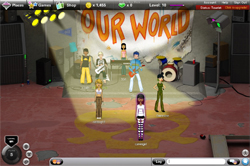Posted by: Kenji Hall on December 10
This just in: After pushing back the launch date by more than a year, Sony’s video game division plans to release PlayStation Home, an online 3-D social networking service, on Dec. 11. Like Linden Labs’ Second Life, Home will let users interact with others through their own computer-generated characters in a virtual setting.
Sony is counting on Home to improve the fortunes of its struggling video games unit. The unit, which is in charge of the PlayStation 3 business, has been a huge drag on earnings, losing roughly $3.8 billion over the past two years. Credit Suisse has predicted that Sony’s gaming unit could eke out a profit this year, but that’s less than certain in the face of a long recession and an unfavorably strong Japanese yen.
Sony officials say they don’t expect an immediate payoff from Home. Their plan is to offer Home as a free software download to all PS3 users, and to charge gaming companies and other brands to create shops, sell goods, host events and advertise. “We think that Home will increase the opportunities for gamers to find each other,” says Ryoji Akagawa, Home senior producer. “That, in turn, will increase the total number of people playing games, which is a key mission for us.”
Home marks the latest phase of a rollout of online services for the PlayStation 3. Recently, Sony added video downloads to the PlayStation Network, which, according to Sony, has attracted 15 million subscribers worldwide. But rival Microsoft still has the lead in offering a full range of online gaming and video-download services, and Nintendo is tops in game console sales. In October, market researcher NPD said Sony sold just 190,000 PS3s in the U.S., compared to 803,210 Nintendo Wii consoles and 371,000 Microsoft Xbox machines. (Since the PS3’s release in November 2006, Sony had sold more than 16.8 million units globally. Nintendo launched its Wii that same month but has sold 34.5 million units.)
It’s unclear what impact the delays will have on Home. The original plan was to have Home ready by autumn 2007. Sony Computer Entertainment chief Kaz Hirai announced the first delay in October, 2007. The company had expected Home to be ready by April of this year, but instead announced another delay. In late August, the company started inviting a limited number of users for a trial.
Continue reading "Sony Launches PlayStation Home (Finally!)"
Posted by: Kenji Hall on November 19
Video game consoles left running round-the-clock can send your annual electricity bill soaring. That’s probably no surprise for most gamers. But the Natural Resources Defense Council, a New York-based conservation group, has conducted a study of gaming machine energy use to raise awareness among gamers and pressure manufacturers into making more energy-efficient machines.
The NRDC’s study found that Xbox 360, PlayStation 3 and Wii machines in the U.S. use about as much electricity in a year as every home in San Diego combined. Much of the energy comes from machines that are left on, but not in use, the NRDC said. Of the three consoles, Sony’s PS3 was the biggest energy hog, followed by Microsoft’s Xbox 360. Nintendo’s Wii is by far the most energy efficient--and even uses less electricity than its predecessor, GameCube.
With more efficient devices and by utilizing existing power-saving features, consumers could save more than $1 billion a year on utility bills and reduce as much global warming pollution per year as the tailpipe emissions from all the cars in San Jose. Specifically, automatic power-down features – which shut off devices if they are left idle for a certain amount of time – are big energy-savers. The feature exists in the Xbox 360 and was recently added to the PlayStation 3, but it is rarely used and leaves room for improvement.
Check out the report: http://www.nrdc.org/energy/consoles/contents.asp
Posted by: Matt Vella on October 22
By Manuel Baigorri
Boot up. Log in. And, hop into a virtual world. Sound familiar? The proliferation of virtual worlds and massively multiplayer online games from Second Life to World of Warcraft hasn't stopped eager entrepreneurs from putting a new spin on the now well-known concept.
 Enter Derrick Morton. Morton's Seattle-based FlowPlay started up in January 2007. Morton's company created ourWorld, a virtual world that can be accessed through a browser. "We saw there were about 100 million people each month playing games but by themselves, a very isolated experience," says the 50-year-old Morton. His first thought, "what the market really needs is a place where people can play games together in a community."
Enter Derrick Morton. Morton's Seattle-based FlowPlay started up in January 2007. Morton's company created ourWorld, a virtual world that can be accessed through a browser. "We saw there were about 100 million people each month playing games but by themselves, a very isolated experience," says the 50-year-old Morton. His first thought, "what the market really needs is a place where people can play games together in a community."
Launched in April, the browser-based ourWorld lets users create their own avatars and play games, go to restaurants, shopping, or to a movie theater to watch YouTube videos with other virtual friends. And, even over the din of the crowded virtual worlds space, ourWorld has garnered attention. Late last year, TechCrunch selected it among the 40 hottest startups in the world. FlowPlay has also been backed by a group of angel investors that put $3.7 million into it in December 2007 with Skype's creators and Intel Capital among them.
Intel may be interested in tapping into ourWorld's target audience: teenage girls. About 60 percent of ourWorld users are girls between 13 and 17 years old. "They are targeting a unique, under tapped audience older than Club Penguin and younger than Second Life," Intel spokeswoman Amy Kircos wrote in an email.
David Cole, a chief analyst with market researcher DFC Intelligence, says targeting a specific demographic and offering multiple business models could prove a strategic advantage. "It's probably an underserved target. I don't think there is going to be as much competition there," says Cole. "There is some potential to carve out a leadership position."
Morton said he wants FlowPlay to swing to a profit by the third quarter of 2009 and hit $9 million in sales by the end of next year. To reach that figure, 50 percent of ourWorld's revenues come from subscription and the other 50 percent from micro transactions. Even though users can play for free, they still need to pay $5.99 a month to enjoy certain features, such as having their own virtual apartment where they can meet up with their friends.
 Ian Bogost, founding partner of Persuasive Games and Associate Professor at the Georgia Institute of Technology, says it is possible that virtual worlds with a business model like ourWorld can succeed "if they offer something people want to spend a few dollars on a regular basis. [But] there is going to be some kind of saturation point. The number of virtual world companies is increasing. It is very risky."
Ian Bogost, founding partner of Persuasive Games and Associate Professor at the Georgia Institute of Technology, says it is possible that virtual worlds with a business model like ourWorld can succeed "if they offer something people want to spend a few dollars on a regular basis. [But] there is going to be some kind of saturation point. The number of virtual world companies is increasing. It is very risky."
Of course, the current financial crisis has put the future of some startups in question. "The prospects for lots of these emerging technologies have taken a significant dent over the last two or three weeks," notes Paul Jackson, a principal analyst at London-based Forrester Research. "A lot of these [startups] are still in a second round of funding and still rely on available money to keep going," he adds.
Still, FlowPlay's Morton is optimistic. Agreeing that the environment to find capital is getting tougher, he says Intel's support provides a buffer. "There is a lot of nervousness in the investment community today. Luckily we have Intel Capital as an investment partner," Morton said.
Posted by: Matt Vella on September 17

The sophisticated software tools used by game-makers are surprisingly similar to those used by engineers and architects to create all manner of suspension bridges and high-rise towers that don’t fall down. Now a company called SoftImage, a division of Avid, has put up a rather in-depth and technical case-study of how designers created the innovative visuals for Konami’s mega-hit Metal Gear Solid 4. The case study isn’t for the faint of heart, but utterly worth checking out.
Posted by: Kenji Hall on August 29
How can Japanese video game companies stay competitive in a crowded global market? “You need a certain amount of scale,” says Square Enix’s President Yoichi Wada. The recent blitz of merger activity in the gaming industry proves that Wada isn’t the only one thinking this. Last month, U.S.-based Activision merged with Blizzard, the gaming unit of French media group Vivendi. And sports-franchise specialist Electronic Arts and “Grand Theft Auto” creator Take-Two Interactive Software are in talks about a potential tie-up.
No surprise, then, that Square Enix is exploring acquisitions of its own. On Aug. 29, the Tokyo company offered to buy Japanese rival Tecmo, a deal that’s worth more than $100 million. At a press conference, Square Enix’s Wada said his company’s role-playing fantasy games such as “Final Fantasy” and "Dragon Quest" and Tecmo’s expertise in fighting games (“Ninja Gaiden”) would make a good match.
Wada repeatedly stressed that the offer was for a “friendly” takeover. He hopes to buy all of the company’s shares but, if that’s not possible, said he would settle for a majority. “I’m awaiting a response [from Tecmo’s management],” he said. “I believe it will happen. I’m praying.”
Square Enix has offered to pay 920 yen ($8.44) for each Tecmo share, which amounts to about a 30% premium. It has enough cash on hand to pull off the transaction without relying on outside financing, Wada said. Square Enix shares ended the day up 2.6%, while Tecmo’s finished 14% higher.
Continue reading "Japan's Square Enix Courts Tecmo"

 Enter Derrick Morton. Morton's Seattle-based FlowPlay
Enter Derrick Morton. Morton's Seattle-based FlowPlay  Ian Bogost, founding partner of Persuasive Games and Associate Professor at the Georgia Institute of Technology, says it is possible that virtual worlds with a business model like ourWorld can succeed "if they offer something people want to spend a few dollars on a regular basis. [But] there is going to be some kind of saturation point. The number of virtual world companies is increasing. It is very risky."
Ian Bogost, founding partner of Persuasive Games and Associate Professor at the Georgia Institute of Technology, says it is possible that virtual worlds with a business model like ourWorld can succeed "if they offer something people want to spend a few dollars on a regular basis. [But] there is going to be some kind of saturation point. The number of virtual world companies is increasing. It is very risky."